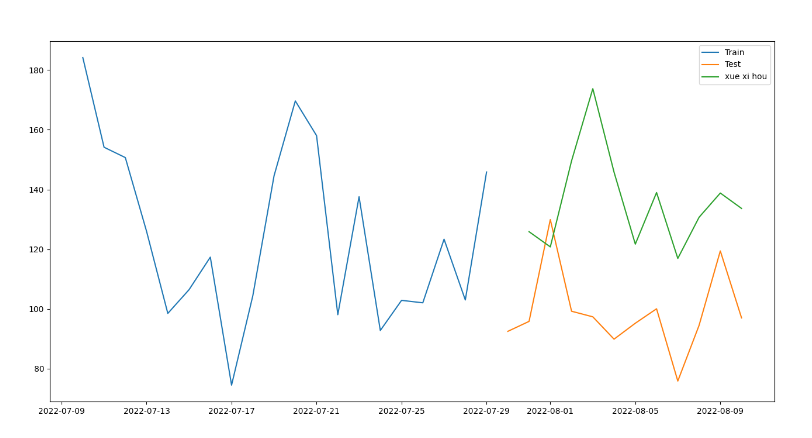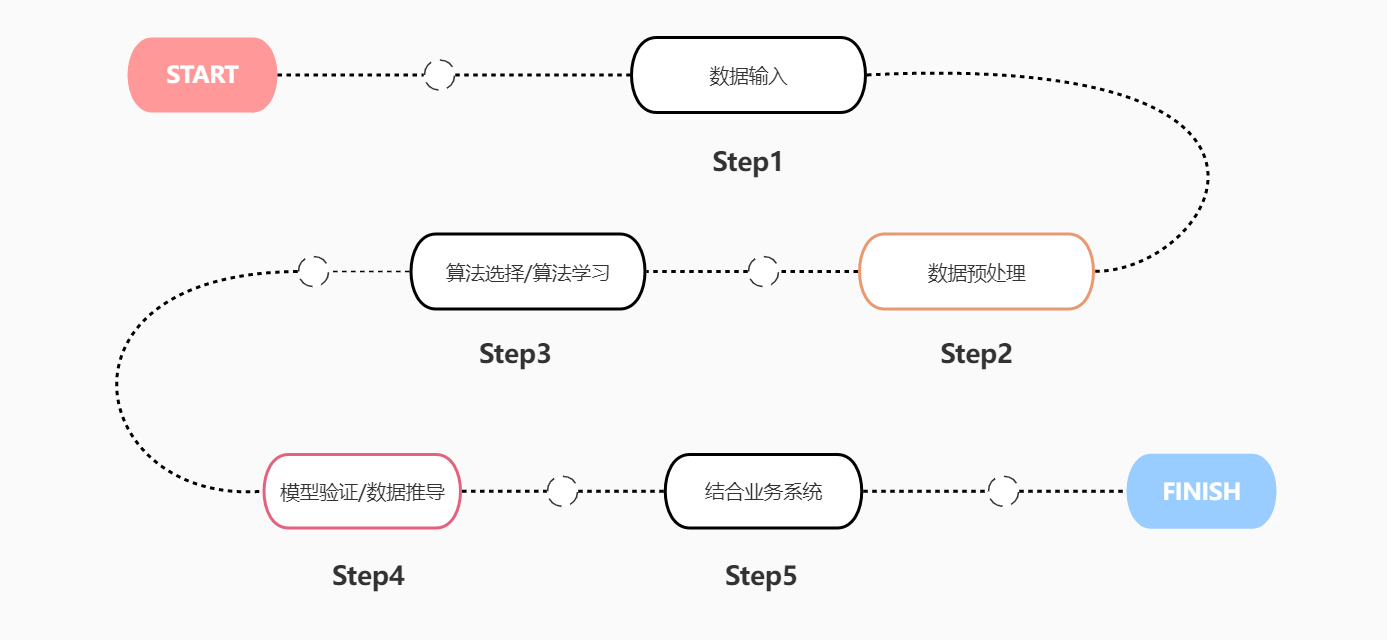前言
以下内容是在学习过程中的一些笔记,难免会有错误和纰漏的地方。如果造成任何困扰,很抱歉。
一、场景描述
描述:这里可以添加本文要记录的大概内容
通过获取当月每天的电表能耗数据,以此来推算未来的每一天的电表数据情况,首先看看实际效果图

这里面包含了三条数据线
- 训练数据 - 蓝色
- 测试核准数据 - 橙色
- 预测值 - 绿色
这里面的预测数据还是有些虚高,主要还是因为维度过低以及数据量过少的缘故,但是从轨迹上看大致还行,在训练数据集越庞大的情况下预测的数据值会更加的准确。
这里面借鉴网友的代码采取了两种方案:
- 自回归移动平均预测模型
- 季节性预测模型
但是数据维度太低了,目前的自变量及因变量只有时间和能耗数据值,所以最终还是选择了自回归移动平均模型。
二、落地实践
描述:这里可以添加本文要记录的大概内容
首先我们将步骤分离为如下几个部分
相关库引入
import pandas as pd import matplotlib.pyplot as plt import statsmodels.api as sm数据集引入
# 数据集导入 df = pd.read_csv('能耗数据01.csv', nrows=33)数据集分类,训练集 or 测试集 - 训练集是给机器学习用,测试集是为了看预测值准不准
# 训练集 / 测试集 train = df[0:20] test = df[20:]数据格式处理
# 时间戳格式处理 df['Timestamp'] = pd.to_datetime(df['Datetime'], format='%Y/%m/%d') df.index = df['Timestamp'] df = df.resample('D').mean() train['Timestamp'] = pd.to_datetime(train['Datetime'], format='%Y/%m/%d') train.index = train['Timestamp'] train = train.resample('D').mean() test['Timestamp'] = pd.to_datetime(test['Datetime'], format='%Y/%m/%d') test.index = test['Timestamp'] test = test.resample('D').mean()预测,查看结果
# 坐标轴刻入 train.Count.plot(figsize=(15, 8), title='Daily Train', fontsize=14) test.Count.plot(figsize=(15, 8), title='Daily Test', fontsize=14) # plt.show() # 自回归移动平均 预测模型 y_hat_avg = test.copy() fit1 = sm.tsa.statespace.SARIMAX(train.Count, order=(2, 1, 4), seasonal_order=(0, 1, 1, 7)).fit() y_hat_avg['SARIMA'] = fit1.predict(start="2022/7/31", end="2022/8/10", dynamic=True) plt.figure(figsize=(16, 8)) plt.plot(train['Count'], label='Train') plt.plot(test['Count'], label='Test') plt.plot(y_hat_avg['SARIMA'], label='xue xi hou') plt.legend(loc='best') plt.show() # 季节性 预测模型 # y_hat_avg = test.copy() # fit1 = ExponentialSmoothing(np.asarray(train['Count']), seasonal_periods=7, trend='add', seasonal='add', ).fit() # y_hat_avg['Holt_Winter'] = fit1.forecast(len(test)) # plt.figure(figsize=(16, 8)) # plt.plot(train['Count'], label='Train') # plt.plot(test['Count'], label='Test') # plt.plot(y_hat_avg['Holt_Winter'], label='xue xi hou') # plt.legend(loc='best') # plt.show()
图解这个流程大概就是这样

在数据维度增多的情况下(标签分类也完整的情况下),数据必然是会越来越准确,但是也需要一个量的积累,上面的示例仅仅只是个一元回归,多元回归的预测必然复杂,但是也复合业务情况,所以以后会补充一些通用完善的业务代码与机器学习相结合,让大家都可以直接套用。
三、完整代码
描述:这里可以添加本文要记录的大概内容
import pandas as pd
import matplotlib.pyplot as plt
import statsmodels.api as sm
# 数据集导入
df = pd.read_csv('能耗数据01.csv', nrows=33)
# 训练集 / 测试集
train = df[0:20]
test = df[20:]
# 时间戳格式处理
df['Timestamp'] = pd.to_datetime(df['Datetime'], format='%Y/%m/%d')
df.index = df['Timestamp']
df = df.resample('D').mean()
train['Timestamp'] = pd.to_datetime(train['Datetime'], format='%Y/%m/%d')
train.index = train['Timestamp']
train = train.resample('D').mean()
test['Timestamp'] = pd.to_datetime(test['Datetime'], format='%Y/%m/%d')
test.index = test['Timestamp']
test = test.resample('D').mean()
# 坐标轴刻入
train.Count.plot(figsize=(15, 8), title='Daily Train', fontsize=14)
test.Count.plot(figsize=(15, 8), title='Daily Test', fontsize=14)
# plt.show()
# 自回归移动平均 预测模型
y_hat_avg = test.copy()
fit1 = sm.tsa.statespace.SARIMAX(train.Count, order=(2, 1, 4), seasonal_order=(0, 1, 1, 7)).fit()
y_hat_avg['SARIMA'] = fit1.predict(start="2022/7/31", end="2022/8/10", dynamic=True)
plt.figure(figsize=(16, 8))
plt.plot(train['Count'], label='Train')
plt.plot(test['Count'], label='Test')
plt.plot(y_hat_avg['SARIMA'], label='xue xi hou')
plt.legend(loc='best')
plt.show()
# 季节性 预测模型
# y_hat_avg = test.copy()
# fit1 = ExponentialSmoothing(np.asarray(train['Count']), seasonal_periods=7, trend='add', seasonal='add', ).fit()
# y_hat_avg['Holt_Winter'] = fit1.forecast(len(test))
# plt.figure(figsize=(16, 8))
# plt.plot(train['Count'], label='Train')
# plt.plot(test['Count'], label='Test')
# plt.plot(y_hat_avg['Holt_Winter'], label='xue xi hou')
# plt.legend(loc='best')
# plt.show()
总结
提示:这里对文章进行总结:
例如:以上就是今天要讲的内容。
本文含有隐藏内容,请 开通VIP 后查看